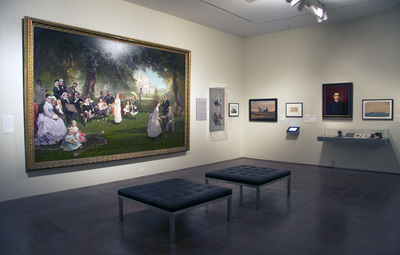Museum & Online Exhibitions
Select projects
|
Hidden in the Walls
The Time Capsule from San Francisco's Lost Sanctuary The Magnes Museum, Berkeley, CA (a collaboration between Jewish Museum San Francisco (now the Contemporary Jewish Museum) and the Judah L. Magnes Museum) Curator |
|
Life/Lines
Permanent Video Installation JCCSF, San Francisco Producer/Curator
permanent installation paying homage to its former historic building and to more than 125 years of communal service. “Life/Lines” is a five-channel montage of video, photography, text and animation, its visual leitmotif derived from the distinctive Mediterranean tiles that once decorated the building’s interior.
|
based on found photos, by contemporary artists Christian Boltanski and Marcelo Brodsky. Juxtaposed in a second gallery was a selection of historic snapshots and family albums. Together, the exhibition and its companion online and film programs explored and challenged the way photographs preserve fragments of memory across generations.
|
Stanford Family Galleries
2014 Reinstallation
Cantor Arts Center, Stanford University
Consulting Curator
2014 Reinstallation
Cantor Arts Center, Stanford University
Consulting Curator
|
2010 (top row) & 2014 (middle, bottom rows) installation views pf The Stanford Family: From a Tragic Loss, a Lasting Institution, photos by Allison Akbay, courtesy Cantor Arts Center, Stanford University.
|
In two galleries located at the heart of the oldest part of Stanford’s Cantor Arts Center, visitors encounter the origin story of both the university and the museum. It’s touching, and not well known: Fifteen-year-old Leland Stanford, Jr., was already a precocious collector of art and antiquities when he died tragically of typhoid fever in 1884. His influential parents (father Leland Sr.—railroad baron and California governor—and mother Jane, Gilded Age patroness) were shattered, but dedicated their remaining lives to building the university and museum that memorialized their only child. I worked with Cantor staff to clarify the existing narrative, which had gotten lost among the artifacts, and overhaul the installation. Key objects and artwork still play starring roles—the Last Spike that united the transcontinental railroad; photographer Eadweard Muybridge’s horse studies commissioned by Leland Sr.; Thomas Hill’s monumental and bizarre “Palo Alto Spring”—but the sequence, look and feel of the galleries are simplified to emphasize an emotional story.
|
|
Web of Ideas: The JMSF Website
Jewish Museum San Francisco Content Director/Producer |
|
|
An early challenge in transforming the Jewish Museum San Francisco, where I was Deputy Director for Programming, into what would become the Contemporary Jewish Museum was to communicate what a culturally-specific museum without a collection might be like. Not only physically--there was a wonderful building designed by Daniel Libeskind to unveil (see left) --but also curatorially. To introduce the notion of a museum connecting art, culture, history and ideas through a Jewish lens, we developed a demonstration website with an interlocking web of 18 vignettes that presented brief artistic experiences linked to key concepts in Jewish life such as Faith, Language and Ritual. The new JMSF website won a number of awards for its innovative approach. (Viewing these vignettes requires your browser to be able to display Flash (.swf) files with an emulator such as Ruffle. Please use the Back arrow on your browser to return to this page; disregard the "Close" button.)
|








